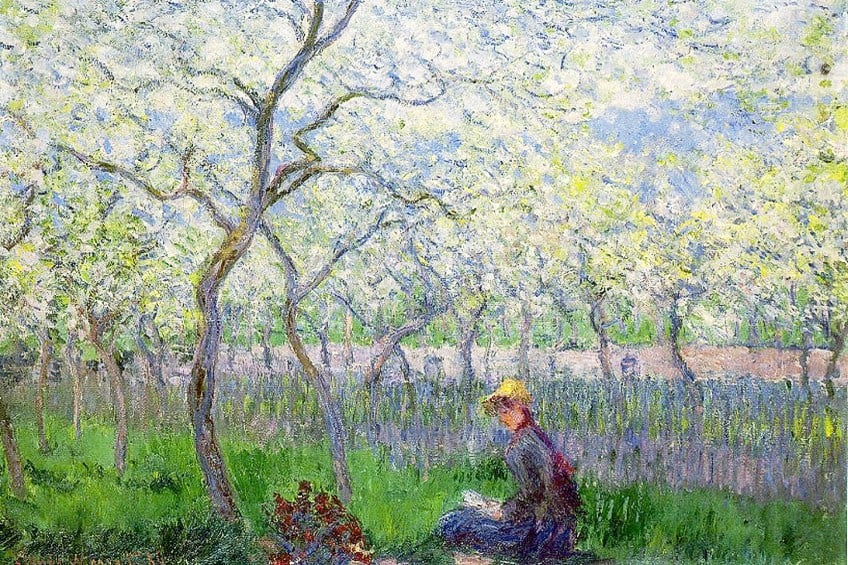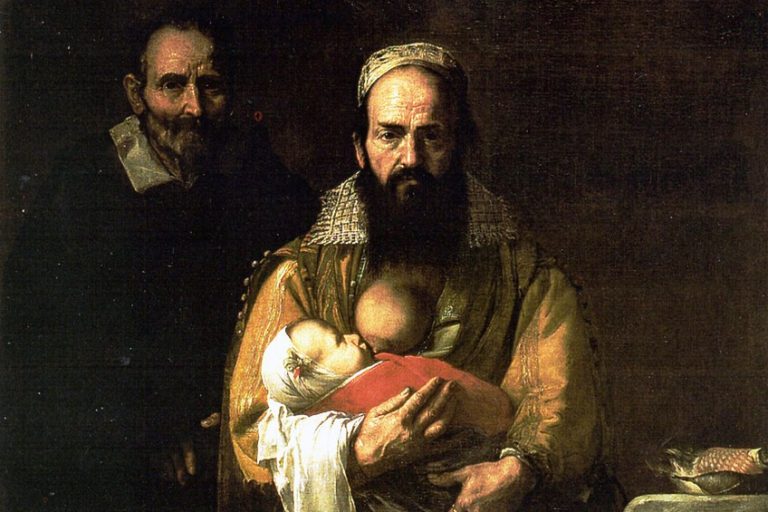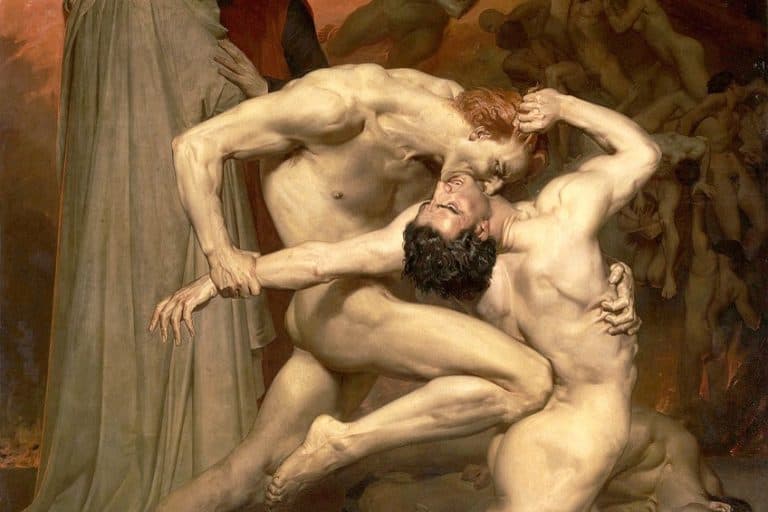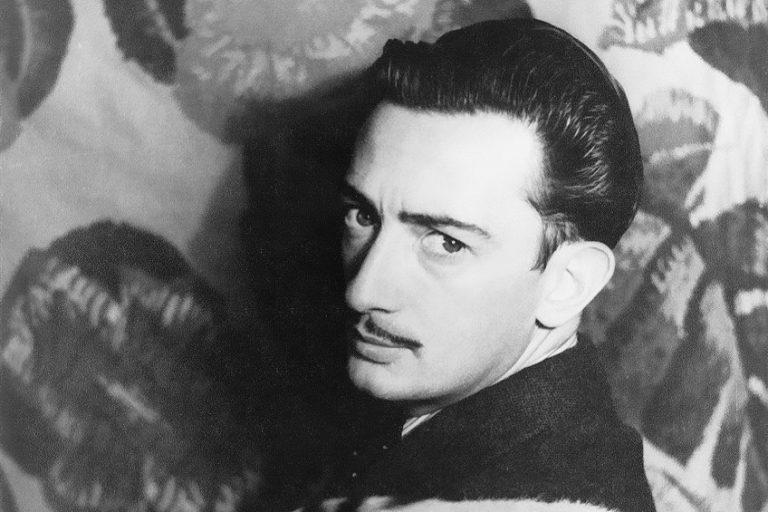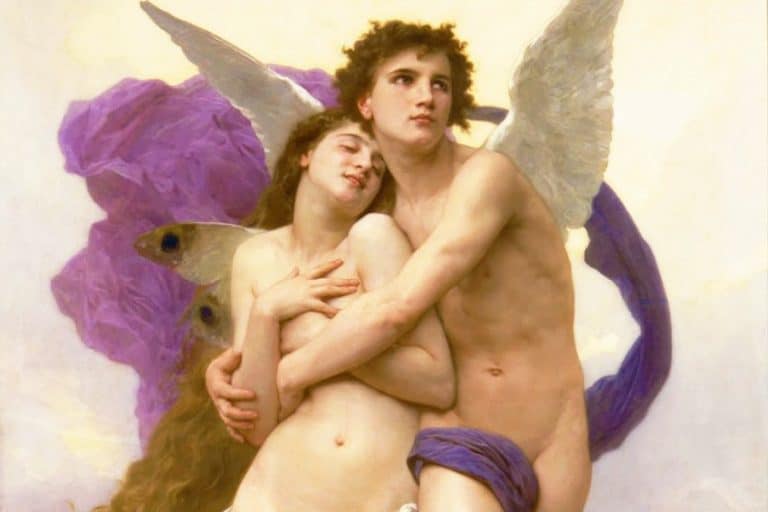Famous Spring Paintings – The Top 11 Paintings Depicting Spring
During the chilly season of winter, it is almost as if the world has fallen into a deep slumber, and in spring, the world awakens once again. Paintings of spring are visual reminders of this period of rebirth in nature. Painting spring can be a delightful experience, as it provides artists with the opportunity to portray this wondrous season and all of the gorgeous colors that are associated with it. In the list below, we shall find out more about the most famous spring paintings!
Our List of Famous Spring Paintings
The trees seem to drip with flowers in the spring, and the leaves start to unfold, heralding the arrival of summer and its lazy nights. Since the Renaissance era, it has served as a source of inspiration for numerous artists across the globe.
La Primavera (1482) by Sandro Botticelli
| Artist | Sandro Botticelli (1445 – 1510) |
| Date Completed | 1482 |
| Medium | Tempera on panel |
| Dimensions (cm) | 202 x 314 |
| Location | Uffizi Gallery, Florence, Italy |
La Primavera is regarded as one of the greatest Renaissance artworks. It is presently housed in Florence’s Uffizi and was ordered to be painted by Lorenzo Pierfrancesco de Medici. Venus, like in Botticelli’s most renowned painting, is at its center. In the artwork, Botticelli depicts six ladies flanked by two males, with a cherub flying over them. They are standing in an orange orchard filled with delicious fruits.
Some observers interpret the woman in the front, sprinkling flowers in front of her, as Primavera, the personification of spring.
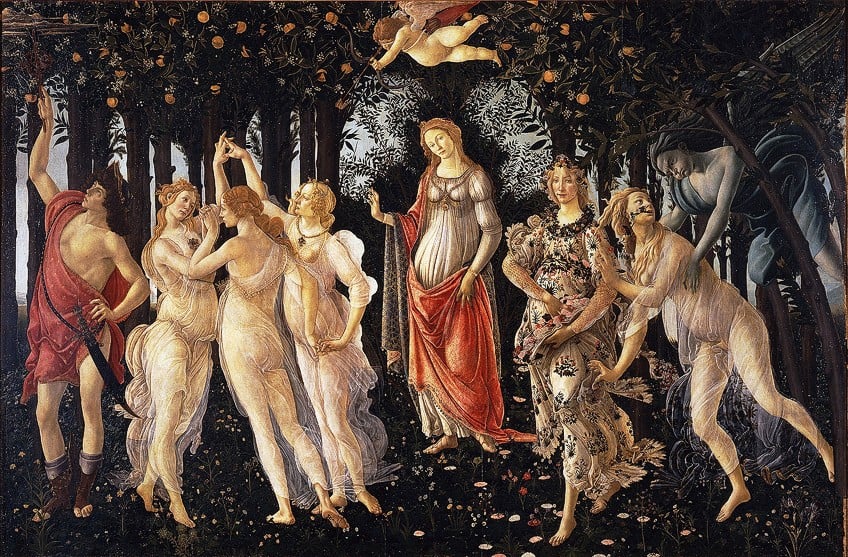
Others see the individuals on the right as Zephyrus clutching the nymph Chloris – according to tradition, he married her, and she was turned into Flora, goddess of spring. Some think that the person with roses represents Chloris’ transformation into Flora. Overall, it is a celebration of fertility and ripeness returning to the planet in the spring. Mercury, the deity of the month of May, is holding a staff, which he could be utilizing to chase away the winter’s clouds. His winged sandals make him easily recognizable.
Spring (1635) by Pieter Brueghel the Younger
| Artist | Pieter Brueghel the Younger (1564 – 1638) |
| Date Completed | 1635 |
| Medium | Oil on panel |
| Dimensions (cm) | 41 x 57 |
| Location | Musée des beaux-arts de Montréal, Montreal, Canada |
A number of Brueghel the Younger’s paintings depict the life of Flemish peasants going about their daily tasks. And much of his work included making paintings from his father’s sketches, Brueghel the Elder. This is a rework of his father’s 1565 artwork, and it depicts a community gathering together to till the soil for planting, sow the seeds, and prepare the cattle for the summer.
We can see men and women laboring in the community gardens, men twirling vines to a trellis, and clusters of individuals dancing in the distance.
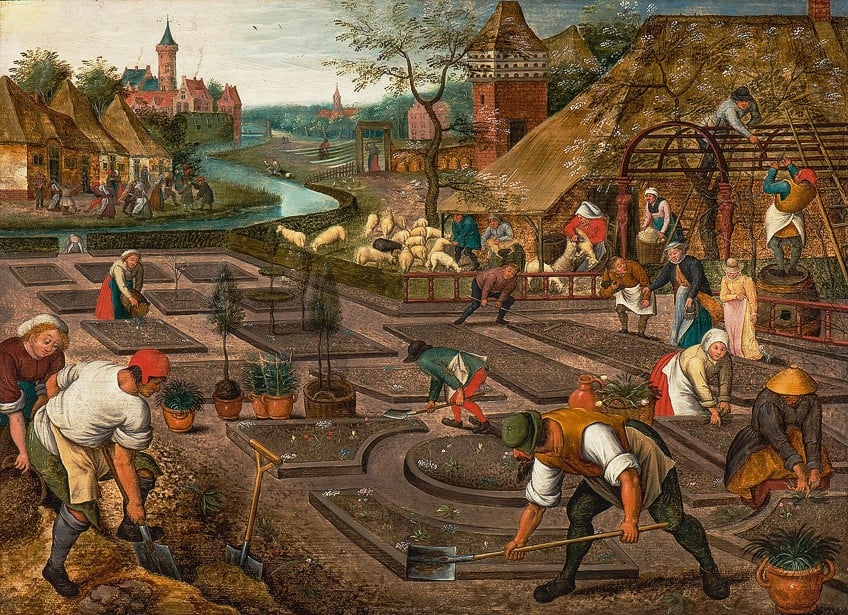
The big individuals in the foreground seem to demand our focus and appreciation in this inspirational image of collaborative work, with their sleeves rolled up and spades digging into the ground. Pieter Breughel the Younger’s variations of the composition are all rendered in reverse to his father’s drawings, and therefore most likely correspond to the engraving created in Hieronymous Cock’s workshop, for which the drawing was done.
Spring (1664) by Nicolas Poussin
| Artist | Nicolas Poussin (1594 – 1665) |
| Date Completed | 1664 |
| Medium | Oil on canvas |
| Dimensions (cm) | 117 x 160 |
| Location | Louvre Museum, Paris, France |
Nicolas Poussin is regarded as one of the great masters of French classicism, particularly of the Arcadian landscape. The series of artworks known as The Four Seasons, completed for the Duc de Richelieu between 1660 and 1664 and currently housed in the Louvre Museum, was one of his final big masterpieces, a theological and aesthetic narrative that tries to reflect on the key periods of human life.
The topic in this spring art painting is nature’s fertility.

His interpretation of spring is inspired by Milton and Virgil. Before the Fall, we see the earthly paradise of Eden, with Adam and Eve nakedly pointing to the Tree of Knowledge. The foliage that surrounds them is rich and splendid, reminiscent of Virgil’s Georgics’ opulent Roman countryside. And, despite their gaze towards the forbidden fruit, there is no snake in Poussin’s Eden. This is the world’s springtime, long before the autumnal winter.
Bullfinch and Weeping Cherry (1834) by Katsushika Hokusai
| Artist | Katsushika Hokusai (1760 – 1849) |
| Date Completed | 1834 |
| Medium | Polychrome woodblock print |
| Dimensions (cm) | 24 x 17 |
| Location | RIDS Museum, Rhode Island, United States |
Apple, cherry, plum blossom, and peach are all imagery associated with the arrival of spring. In Japan, blossom is particularly significant as a symbol of the transient nature of all things, since it blooms in spring and then fades away. Katsushiki Hokusai was a master of Japanese woodblock painting.
Hokusai’s artistic path was distinguished by a restless temperament, and he used many pseudonyms during his career.

He constantly modified his approach and techniques in order to progress and better his work. This painting was part of his 1834 series Small Flowers, which depicted a branch of cherry about to blossom with a bird sitting on a bough against a backdrop of deep, Prussian blue. The text on one side of the artwork is a Setsuman haiku that reads, ‘A solitary bird emerges, wet by dew, from morning cherry blossom’; they focus one’s attention on this one moment of calm, a single moment cut from the inescapable pull of time.
Spring Bouquet (1866) by Pierre-Auguste Renoir
| Artist | Pierre-Auguste Renoir (1841 – 1919) |
| Date Completed | 1866 |
| Medium | Oil on canvas |
| Dimensions (cm) | 105 x 80 |
| Location | Fogg Museum, Cambridge, United States |
Despite its seeming looseness, this famous spring art painting has a strict structure. With an asymmetry as wild and free as nature itself, the flowers burst over into the lower left-hand corner in joyful abundance. However, the artist immediately begins to correct this imbalance. Renoir has created a deep shadow region to the right of the container, rich in purple tones, shaggy in form, and starkly contrasting with the area of light below it. The placement of the ruler-straight lines in the lower right corner of the painting is especially important. When Renoir created this painting, the Impressionist approach had not yet matured.
The brushwork is strong, and the color is thick and rich, evoking Gustave Courbet. And, instead of a generalized appearance of dazzling color, which would later imply rather than represent flowers, the petals are individual and distinct here.
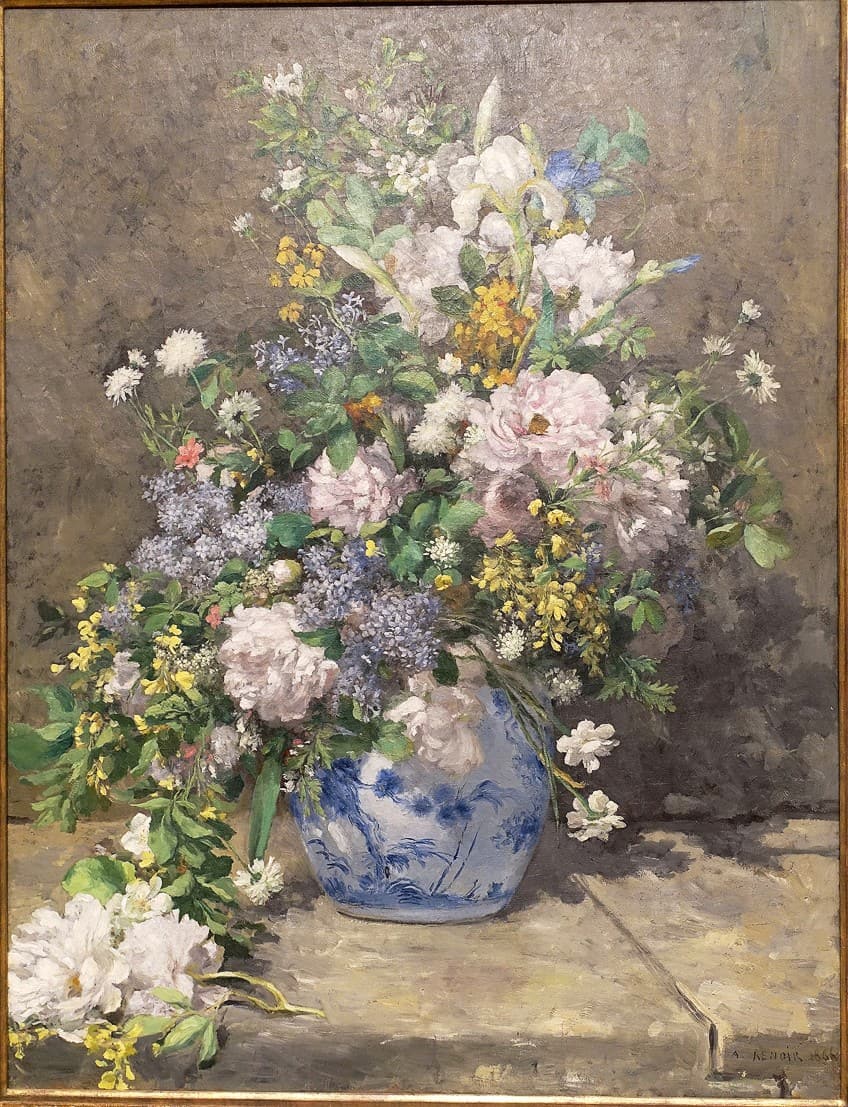
However, the canvas shines with color and light, hinting that Impressionism is on the horizon; there is a feeling of an impression of the outdoors that Renoir has caught in this picture. Accents of black brighten up the silvery blue tone, and the gorgeous scattering of yellow starlike blooms is pure pleasure. Renoir was only at the beginning of his profession when he made this painting of spring, but his taste was already extraordinary.
The Small Meadows in Spring (1881) by Alfred Sisley
| Artist | Alfred Sisley (1839 – 1899) |
| Date Completed | 1881 |
| Medium | Oil on canvas |
| Dimensions (cm) | 54 x 73 |
| Location | National Gallery, London, United Kingdom |
Sisley is one of the Impressionists’ most underappreciated painters. He was, however, an innovator of the plein-air approach and the Impressionist style, working with Monet and Pissaro from the beginning. And, unlike some of the artists originally involved in the movement, he never abandoned the Impressionist landscape. Sisley was obliged to leave Paris in 1880 due to financial constraints and relocated to the countryside situated to the west of the capital. His work took on fresh life during this period.
This painting of spring, “Small Meadows”, is a rather subdued picture; the trees are bare, and there is no sign of cherry blossom.
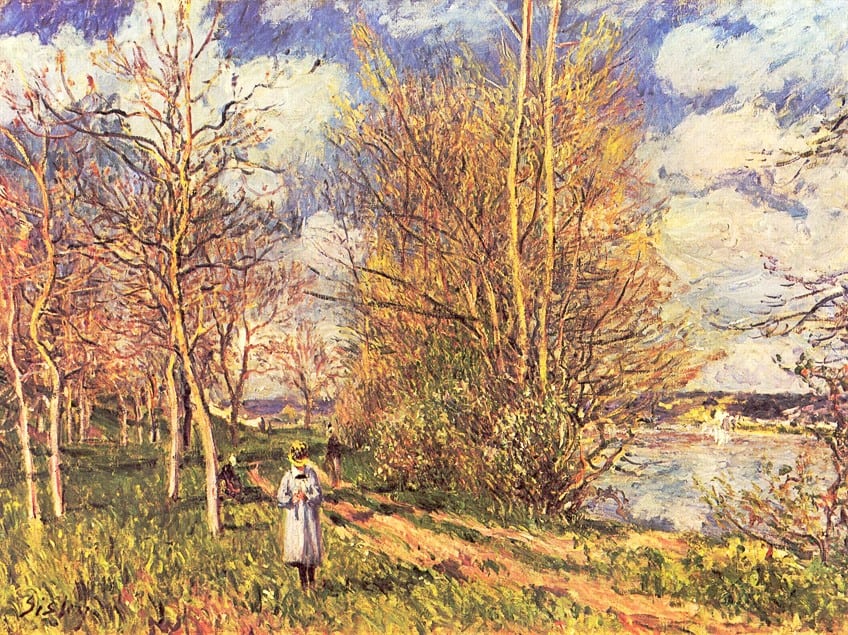
In the front, however, he shows his newborn daughter as a sign of rebirth, similar to Botticelli’s Primavera, and as a symbol of newborn life. Sisley created multiple versions of this view along the Seine. This artwork represents the woodland trail that ran along the Seine River’s banks between the towns of By and Veneux in the countryside of France, just south of Paris.
An Orchard in Spring (1886) by Claude Monet
| Artist | Claude Monet (1840 – 1926) |
| Date Completed | 1886 |
| Medium | Oil on canvas |
| Dimensions (cm) | 80 x 64 |
| Location | Fitzwilliam Museum, Cambridge, United Kingdom |
Critics have remarked that Orchard in spring is the best of all Impressionist paintings of spring. It depicts the Giverny garden’s orchards in Normandy, which is connected to the home he rented from 1883 and subsequently purchased altogether. Those same gardens, with their streams and bridges, would eventually inspire his water lily paintings.
In 1886, he created this scene in the orchard, with its magnificent vault of apple blossoms that seemed to brighten the entire painting.
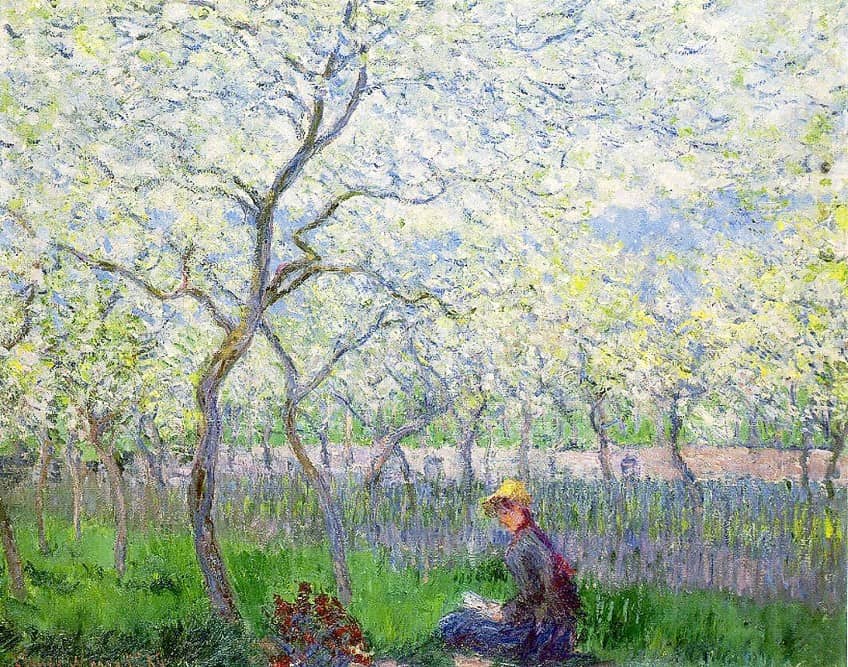
The artist’s mistress at the time, Suzanne Hoschedé, is thought to be seated behind her mother, who would eventually become Monet’s second wife. It’s an excellent representation of what was known as ‘Violettomania’ during that period.
The Pink Peach Tree (1888) by Vincent van Gogh
| Artist | Vincent van Gogh (1853 – 1890) |
| Date Completed | 1888 |
| Medium | Oil on canvas |
| Dimensions (cm) | 80 x 59 |
| Location | Van Gogh Museum, Amsterdam, Netherlands |
By early 1888, Van Gogh and his brother Theo’s position had become dire, and their living arrangement had become untenable. Van Gogh found the Paris that had once captivated him suffocating and stifling. “It seems to me nearly difficult to operate in Paris if one does not have some place of refuge where one may rest and regain one’s calm and poise back”, he remarked in a letter to Theo. Van Gogh paid his first and final visit to Seurat’s studio with Theo on the 20th of February, 1888, and then took a train to Arles in southern France.
Van Gogh wrote to Gauguin, “I forever cherish the feelings that the trip from Paris to Arles evoked. How I kept checking to see if I had arrived in Japan!”.
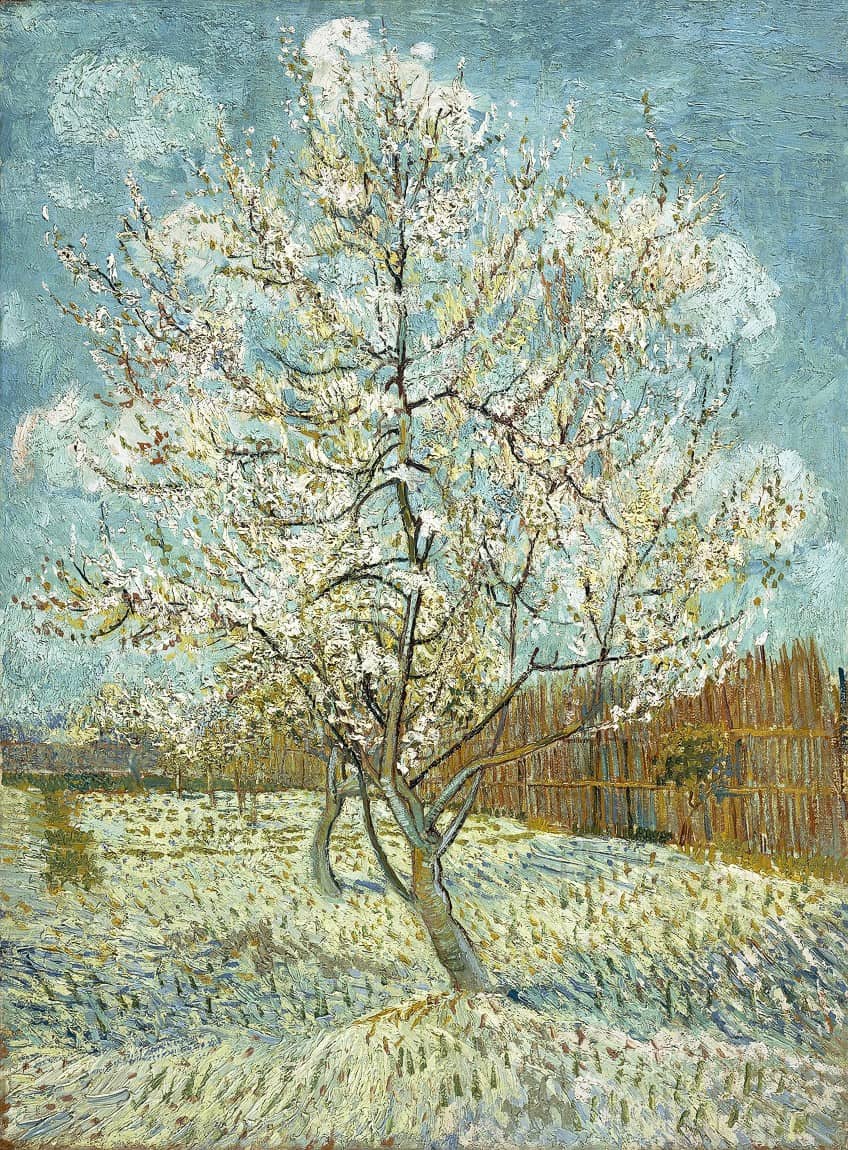
Ironically, when he arrived at Arles, it was snowing, but when the snow melted, the trees burst into blossom, and his perception of the South was realized for a brief time. He started a series of paintings depicting trees in bloom, and the blossom became a metaphor for spiritual rebirth, a picture of beauty born after the severe winter, much as a piece of art is born only after much anguish and frustration.
Plum Trees in Blossom Éragny (1894) by Camille Pissarro
| Artist | Camille Pissarro (1830 – 1903) |
| Date Completed | 1894 |
| Medium | Oil on canvas |
| Dimensions (cm) | 60 x 73 |
| Location | Ordrupgaard, Copenhagen, Denmark |
Pissarro focused on his immediate environment. He was drawn to depicting ordinary life in the family’s home, the hamlet, or the fields. His works of art are usually scenic, in a style influenced by Millet and Corot. Pissarro and his family relocated to Éragny, northwest of Paris, in 1884. This scene is from the house’s garden and depicts it in a dazzling spring light.
The focus is on the movement of light in the blossoming fruit trees, and Pissarro has completely embraced Impressionistic techniques.

Pissarro was the most senior of the Impressionist painters. He participated in all eight iconic Impressionist exhibitions and became known as a type of creative father figure to artists such as Paul Gauguin. The consistent investigation of what may be considered classic Impressionism is a prominent characteristic of his work, only broken by a brief time at the end of the 1880s when he joined the Pointillists.
Cherry Blossom Viewing (1894) by Toyohara Chikanobu
| Artist | Toyohara Chikanobu (1838 – 1912) |
| Date Completed | 1894 |
| Medium | Ink on paper |
| Dimensions (cm) | 35 x 70 |
| Location | MFA Boston, Boston, United States |
The tradition of Hanami, or cherry watching, in which parties go out to admire the blossoms and dine among the trees, demonstrates the significance of blossoms in Japanese society. Yoshu Chikanobu was a prominent artist during the Meiji period, which lasted from 1868 to 1912. In his triptych of woodblock prints, he depicts women of the Imperial Palace at Chiyoda in Tokyo, as they leave the palace to observe the cherry blossoms in bloom, a ritual that has been practiced in Japan since at least the 8th century.
Between March and May, the cherry blossoms in Japan migrate north along the length of the islands, and its progress is diligently tracked.
Spring (1924) by Georgia O’Keeffe
| Artist | Georgia O’Keeffe (1887 – 1986) |
| Date Completed | 1924 |
| Medium | Oil on canvas |
| Dimensions (cm) | 35 x 46 |
| Location | Art Institute of Chicago, Chicago, United States |
Georgia O’Keeffe, together with Alfred Stieglitz, her husband, was a pivotal player in American Modernism. Many of her landscape and floral images, notably her 1924 piece Spring, may be seen in the Art Institute of Chicago. Georgia O’Keeffe painted the little house at Lake George, New York, that contained Stieglitz’s darkroom in the spring. Stieglitz photographed this structure the same year, on a snowy day, and the pair regularly dealt with the same topics in their works.
O’Keeffe chose a springtime scene, using luscious pastel colors for the many blossoming trees.
She also made alterations that highlight her aesthetic decisions as a painter: she reduced the building by removing the window, chimney, and horizontal siding from the home; and she expanded and curled the flagpole, emphasizing the vertical format of the picture. She depicted the structure with an incredible mass of vegetation, full of purple, green, and mauve colors that appear to burst over and stretch up to become one with the clouds.
All of the famous spring paintings in the list above are examples of the myriad of ways that spring can be portrayed. Painting spring is a favorite theme for many artists, as the season is always bursting with color and life. Paintings of spring bring much joy to those who view them as well, allowing viewers to enjoy the sense of being in a beautifully lit and warm environment, no matter where they are.
Frequently Asked Questions
Why Do Artists Make Paintings of Spring?
Spring is a season of rebirth and regeneration. Nature awakens after a cold and inert winter, with sprouting leaves, blossoms, and animals returning from their winter migration. Spring’s symbolism appeals to artists because it signifies optimism and the cyclical aspect of life. The vivid colors of the flowers, the thick vegetation, and the soft and warm light all combine to create aesthetically spectacular vistas. Artists are naturally drawn to capturing the beauty of their surroundings, and spring provides a plethora of stunning scenarios. The coming of spring causes a noticeable shift in people’s moods and emotions. It is linked to emotions of joy, happiness, and alleviation from the winter blues.
What Are the Most Famous Spring Paintings in the World?
There are many famous spring paintings for you to enjoy in galleries and museums worldwide. One of the most well-known of these paintings was produced by Sandro Botticelli and is known as La Primavera (1482). Many famous artists have also created their interpretations, such as Vincent van Gogh, who created The Pink Tree in 1888. In the modern era, artists such as Georgia O’Keeffe have also produced paintings of spring, such as her Spring (1924).
Isabella studied at the University of Cape Town in South Africa and graduated with a Bachelor of Arts majoring in English Literature & Language and Psychology. Throughout her undergraduate years, she took Art History as an additional subject and absolutely loved it. Building on from her art history knowledge that began in high school, art has always been a particular area of fascination for her. From learning about artworks previously unknown to her, or sharpening her existing understanding of specific works, the ability to continue learning within this interesting sphere excites her greatly.
Her focal points of interest in art history encompass profiling specific artists and art movements, as it is these areas where she is able to really dig deep into the rich narrative of the art world. Additionally, she particularly enjoys exploring the different artistic styles of the 20th century, as well as the important impact that female artists have had on the development of art history.
Learn more about Isabella Meyer and the Art in Context Team.
Cite this Article
Isabella, Meyer, “Famous Spring Paintings – The Top 11 Paintings Depicting Spring.” Art in Context. August 10, 2023. URL: https://artincontext.org/famous-spring-paintings/
Meyer, I. (2023, 10 August). Famous Spring Paintings – The Top 11 Paintings Depicting Spring. Art in Context. https://artincontext.org/famous-spring-paintings/
Meyer, Isabella. “Famous Spring Paintings – The Top 11 Paintings Depicting Spring.” Art in Context, August 10, 2023. https://artincontext.org/famous-spring-paintings/.


